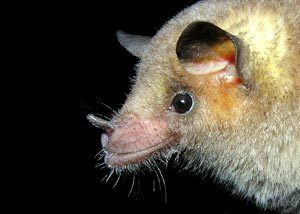Order Chiroptera Genus Leptonycteris Higher classification Saussure's long-nosed bat | Phylum Chordata Family Phyllostomidae Scientific name Leptonycteris nivalis Rank Species | |
 | ||
Similar Saussure's long‑nosed bat, Bat, Lesser long‑nosed bat, Southern long‑nosed bat, Leaf‑nosed bat | ||
The greater long-nosed bat or Mexican long-nosed bat (Leptonycteris nivalis) is a species of bat in the family Phyllostomidae. It is found in Mexico, the United States, and in Guatemala. Its natural habitat is temperate forests. It is threatened by habitat loss. This species of bat is the pollinator of the blue agave plant, the source of tequila.
Not much is known about these bats in relation to their habits. They migrate in response to seasonal changes and the availability of food. When the young are born during midsummer, the females of the species gather in large nursery colonies. In the late summer, both male and female bats are known to roost in the caves of southern Mexico. They have been observed in groups as large as 13,000 individuals while roosting. Analysis of some data suggests that during the last 30 years their populations have been in decline.
Mexican long-nosed bats synchronize their arrival in Texas with the summer blooming cycle of agave plants on which they rely for pollen and nectar. In Mexico, they also eat the nectar, pollen, and fruit of giant columnar cacti as well as insects. The insects are often picked up while the bats are feeding within the flowers. Like hummingbirds, they hover in front of plants and insert their long noses and tongues deep into the flowers to sip nectar. It is theorized that if this nectarivorous species of bat is lost that the agriculturally important agave plants will suffer.
In Texas, these bats occur in agave and desert-scrub woodlands at elevations of 4,900 to 7,500 feet. They are seldom found far from the agaves and cacti upon which they depend. These bats are found north of the US border only from June to August. Also, they inhabit the cooler climate of the high elevation pine and oak forests of the southwestern United States. They roost in caves, abandoned mines, and cliff-face cavities in groups ranging from a few to several thousand. Many appear to make relatively long seasonal migrations, remaining active in warm climates year-round. These bats are seldom seen except at night at hummingbird feeders.
In 1995, The Program for the Conservation of Migratory Bats between Mexico and the United States was started by a concerned group of international bat specialists. This was in response to a decline of a number of bat species in Mexico. The mission of the PCMM is to recover these migratory species in an effort to protect them. Three main areas of focus for the PCMM are research, education, and conservation. The program has been so successful that it serves as an example for conservation efforts in other countries in Latin America.
